From the tiniest Chihuahua to the biggest Great Dane, every dog needs exercise, which means that multiple times a day, it's time to take them on a walk. But there's a difference between a dog on a leash and a dog that is leash-trained. A well-trained dog will walk with a little bend in the leash at all times. They don't bark or lunge at strange sights, humans, or other dogs. And they keep a good pace, frequently checking in with you with offered eye contact.
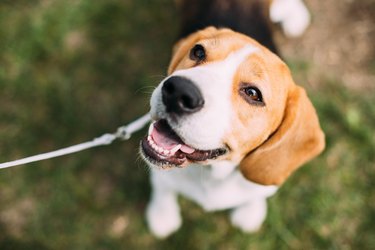
Video of the Day
Most dogs don't start out this well-trained, and each dog needs a little work to make them a good walker. Here are some simple steps that you can use as you start out leash training your pup into the perfect canine citizen.
Video of the Day
Make leash time the most fun time
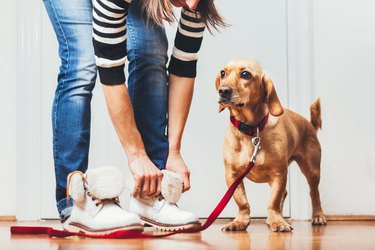
Being strapped into a leash and collar for the first time can be a little bit stressful for your pup, so you want to make this process as pleasant and happy as possible. If you don't, you might end up with a pup that resists putting on a leash or a harness. Our dog developed a love of playing a game with her harness. She knew that grabbing the harness meant we wanted her to do something, so she would run away, hide, and try to "play" to make the attention last as long as possible. We had to use a lot of treats and training time to change that reaction to make her easier to take on walks.
So that your dog doesn't develop an odd association with or fear of their leash and harness, start your leash and harness time inside. Keeping unnecessary outside distractions at first helps to focus your pup. Reward your dog with lots of treats and praise as you put on their leash and harness and walk around the house. This will teach them that getting dressed and walking on a leash equals treats and love, which helps establish it as a positive experience. While you're walking, remember to keep the leash as loose as possible — the idea is to make your puppy barely notice that a leash is even on, and rather than be controlled, which can result in tugging or biting at the leash, your dog is reinforced for following you, which forms a positive association.
As you progress with your training, make sure not to abandon this entirely. Continue to give praise and the occasional treat when getting your dog walk-ready, so they keep associating walks with positivity, even when the walks start to become more challenging. To encourage your dog to stay close, try offering a small treat on the floor by your heel so your puppy learns to look right by your side for positive reinforcement.
Try to stop pulling as much as possible
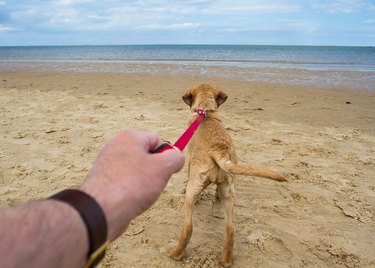
One of the biggest complaints of anyone who's ever walked a dog is pulling on the leash. Dogs pull for all kinds of reasons – excitement, fear, curiosity, or because there's a specific stimuli they want to get at. Pulling is a nuisance for owners of small dogs and can be a real challenge for anyone trying to control a larger dog. The best way to limit pulling is to do your best to avoid known triggers that may incite a pull response — for some dogs this could be passing a dog on a city sidewalk, or chasing squirrels. Because avoiding certain things all of the time is unlikely, start training your dog not to pull as early as possible and stay consistent with that training always.
Whenever your pup pulls on their leash, the American Kennel Club suggests that humans "become a tree." Stand still in your spot until your dog stops pulling. Holding your ground helps to prevent accidentally reinforcing the act of pulling. Obviously, this is more difficult if you have a particularly large dog, but there are special harnesses created for those dogs so that they're more likely to stop themselves when they pull.
If your dog lunges or barks, redirect their attention
The best way to teach your dog not to bark or lunge is to redirect their attention and then reward them.
First, you want to train yourself not to pull or drag your dog away when they're barking or lunging. "The increased pressure on them from a pull can cause them to feel trapped and thus incites behaviors that look aggressive," explains trainer Cassie Pestana, KPA-CTP, CPDT-KA. Think of it like this: if a dog is put in a situation where their fight of flight response kicks in and they're restrained by a leash that prevents them from fleeing, the only option left is the fight response. It may not actually be aggression, but reactions can appear that way when triggered. Also, that kind of reaction suggests that you are also nervous or worried about their behavior, which can be contagious for your dog.
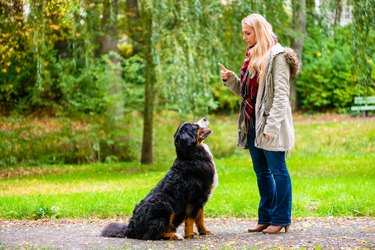
Instead, remain as calm as possible and try to redirect their attention using treats. If they've learned the "watch me" command in training, that's a great way to gain their attention. The key is to redirect and then reward when possible, but if your dog does bark, it's better to reward them for that than not reward them at all. This will help build positive associations around the trigger, and can help your dog become less affected by it over time.
Also, you'll want to do your best to maintain distance between your pup and things that make them react. Don't pass too close or let your pup "greet" other dogs until they can remain calm as they approach them. "Keeping a bit of distance will help your dog be able to work on all the training mentioned in the above paragraph," says Pestana. "Dogs over the threshold are not able to eat, learn, and feel okay." However, you also don't need to avoid going on walks or exposing your pup to those things. It's only by repetition that they'll learn to chill, so keep taking them out, but try to slowly introduce them to things that seem scary.
Soon, you and your pup will be struttin' your stuff all through town! We know you'll be champs!
Choose your equipment carefully
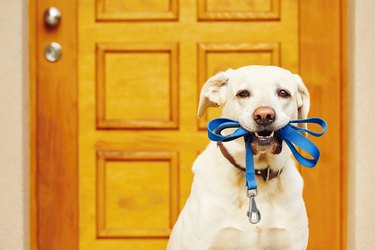
Of course, one of the keys to starting your leash training out on the right paw is selecting the best equipment for your dog. The two things you need to walk your dog are a leash and a collar or harness.
- Leashes – most experts agree that when you're starting out with dog training, it's important to choose a standard leash, about 6 feet long. Long leashes, even 20 to 30 foot lines that allow your dog to explore, can be very convenient once your dog is trained, but it's best to teach good leash behavior on a leash that gives your pup limited range. (Retractable leashes are no longer recommended because they are dangerous.)
- Collars and/or harnesses – there are a lot of options when choosing collars and harnesses. Front-clip harnesses work well for dogs that tend to pull on their leash, because they help redirect the dog's pulling with minimal discomfort. Because the leash attaches in the front of the chest rather than around the neck, it doesn't put pressure on that area. Some collars are also specially designed for certain types of dogs and behaviors. Generally, Y-shaped harnesses, like the Balance Harness, the Freedom Harness, and the Pet Safe 3-in-1 Harness are recommended over H-shaped varieties, according to Pestana. If you need a little more customized solution, talk to your vet or a qualified dog trainer for options that best fit your pup.